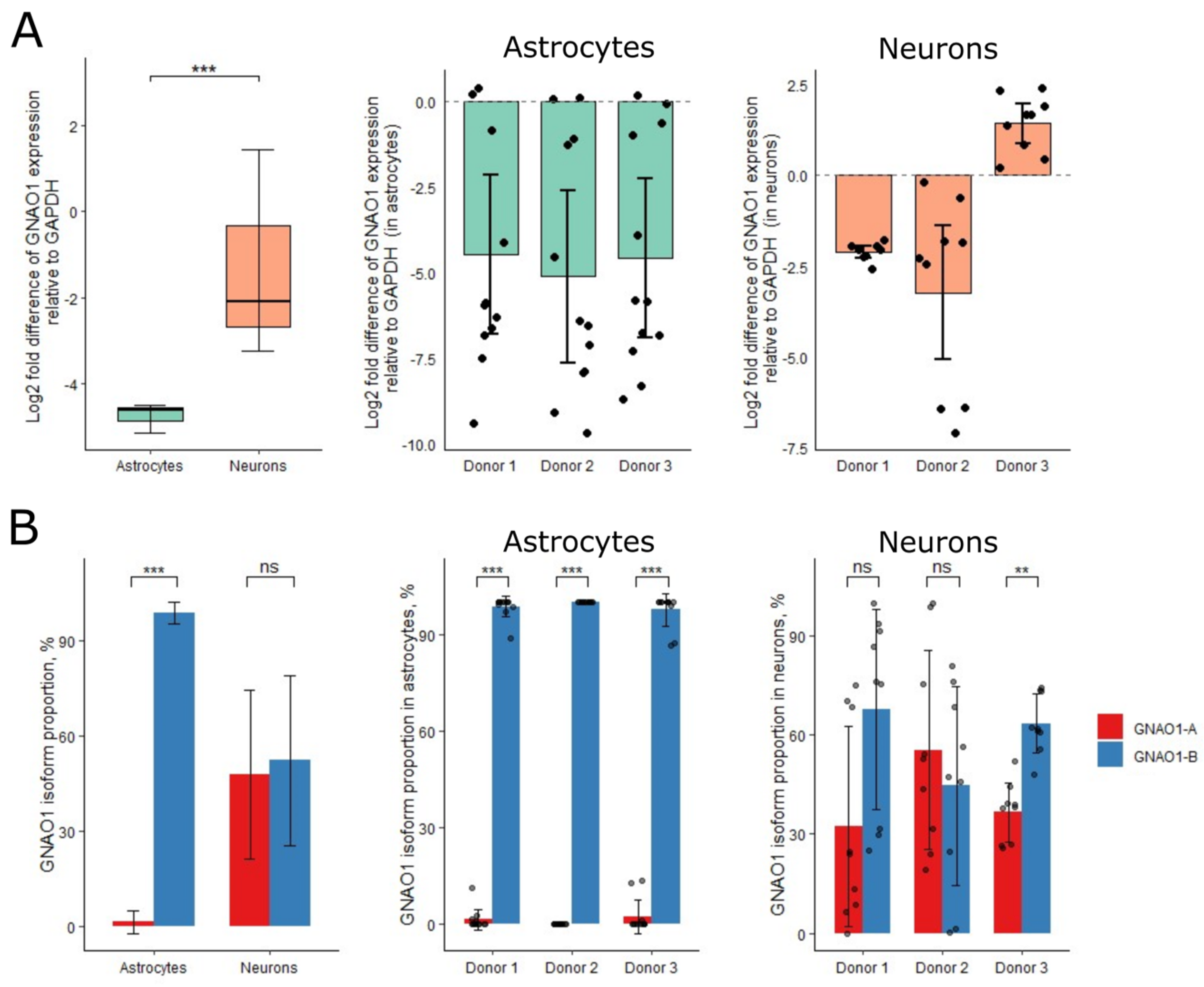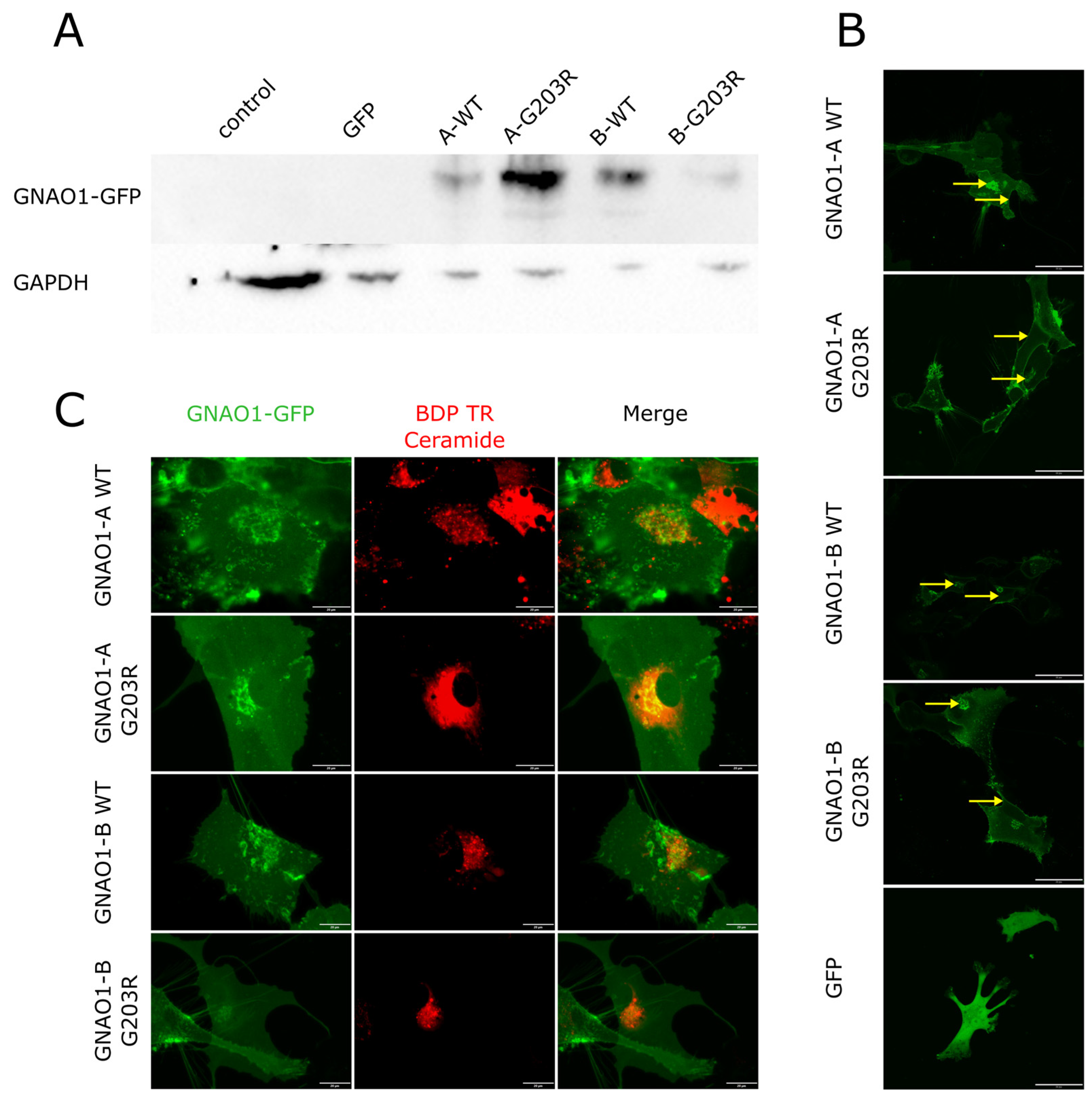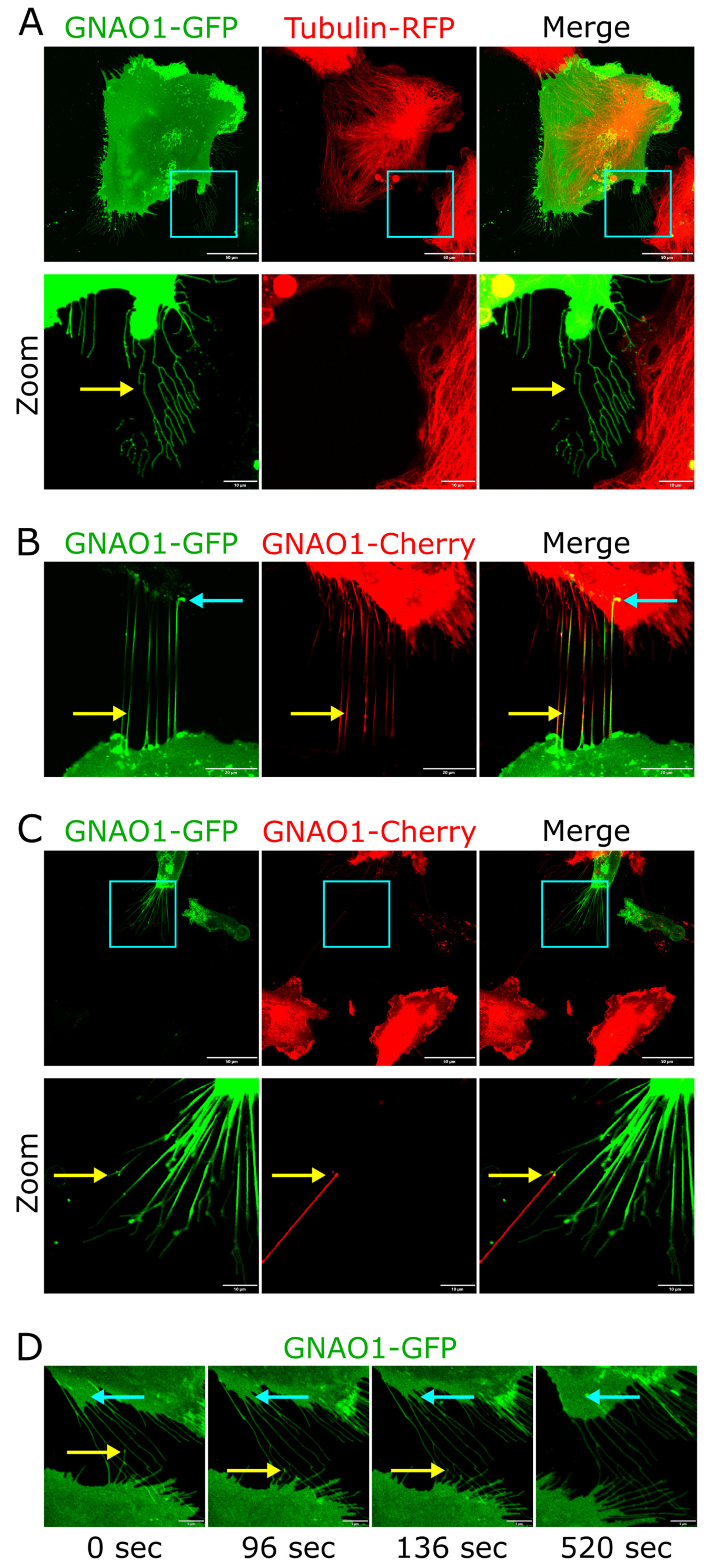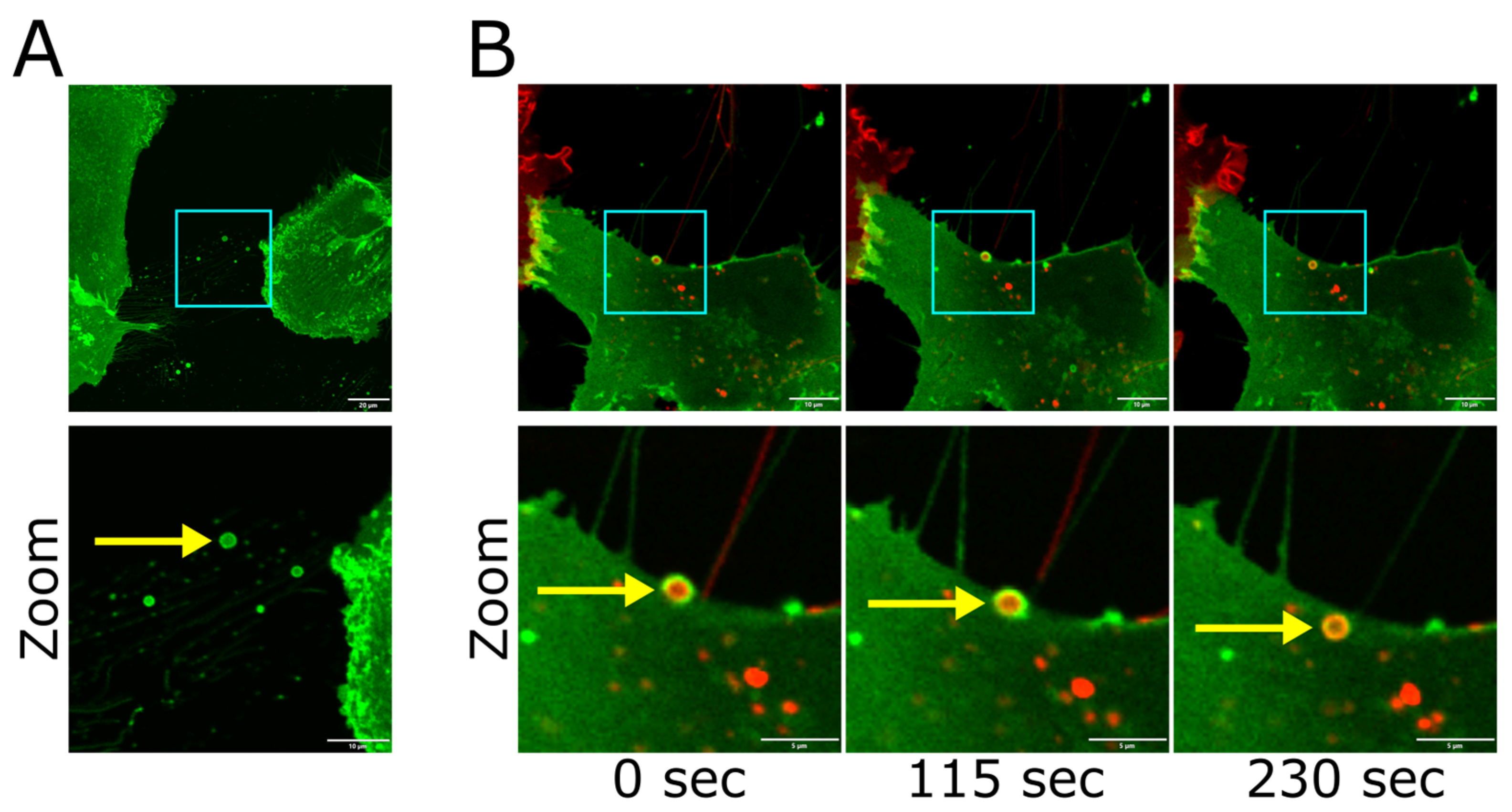The GNAO1-B Splice Variant Is the Predominant Isoform in Human Astrocytes and Localizes to Retraction Fibers and Migrasomes
Abstract
1. Introduction
2. Materials and Methods
3. Results
3.1. Cell Model Generation
3.2. Astrocytes Predominantly Expressed GNAO1-B Variant
3.3. GNAO1-A and GNAO1-B Showed No Difference in Intracellular Localization in Astrocytes
3.4. GNAO1 Localized in Astrocytic Retraction Fibers
3.5. GNAO1 Localized in Astrocytic Migrasomes
3.6. GNAO1-A Overexpression Reduced Astrocytic Calcium Activity
4. Discussion
5. Conclusions
Supplementary Materials
Author Contributions
Funding
Institutional Review Board Statement
Informed Consent Statement
Data Availability Statement
Acknowledgments
Conflicts of Interest
Abbreviations
| AA | Amino acid |
| BDNF | Brain-derived neurotrophic factor |
| cDNA | Complementary DNA |
| CDS | Coding sequence |
| FBS | Fetal bovine serum |
| GDNF | Glia-derived neurotrophic factor |
| GPCR | G-protein-coupled receptor |
| hESC | Human embryonic stem cells |
| IPSC | Induced pluripotent stem cells |
| NEAA | Non-essential amino acids |
| P/S | Penicillin–streptomycin |
| PBS | Phosphate-buffered saline |
| SR | Serum replacement |
| UTR | Untranslated region |
| WT | Wild type |
References
- Sternweis, P.C.; Robishaw, J.D. Isolation of two proteins with high affinity for guanine nucleotides from membranes of bovine brain. J. Biol. Chem. 1984, 259, 13806–13813. [Google Scholar] [CrossRef] [PubMed]
- Larrivee, C.L.; Feng, H.; Quinn, J.A.; Shaw, V.S.; Leipprandt, J.R.; Demireva, E.Y.; Xie, H.; Neubig, R.R. Mice with GNAO1 R209H Movement Disorder Variant Display Hyperlocomotion Alleviated by Risperidone. J. Pharmacol. Exp. Ther. 2020, 373, 24–33. [Google Scholar] [CrossRef] [PubMed]
- Nakamura, K.; Kodera, H.; Akita, T.; Shiina, M.; Kato, M.; Hoshino, H.; Terashima, H.; Osaka, H.; Nakamura, S.; Tohyama, J.; et al. De Novo mutations in GNAO1, encoding a Gαo subunit of heterotrimeric G proteins, cause epileptic encephalopathy. Am. J. Hum. Genet. 2013, 93, 496–505. [Google Scholar] [CrossRef] [PubMed] [PubMed Central]
- Domínguez Carral, J.; Reinhard, C.; Ebrahimi-Fakhari, D.; Dorison, N.; Galosi, S.; Garone, G.; Malenica, M.; Ravelli, C.; Serdaroglu, E.; van de Pol, L.A.; et al. Dyskinetic crisis in GNAO1-related disorders: Clinical perspectives and management strategies. Front. Neurol. 2024, 15, 1403815. [Google Scholar] [CrossRef] [PubMed] [PubMed Central]
- Kim, S.Y.; Shim, Y.; Ko, Y.J.; Park, S.; Jang, S.S.; Lim, B.C.; Kim, K.J.; Chae, J.H. Spectrum of movement disorders in GNAO1 encephalopathy: In-depth phenotyping and case-by-case analysis. Orphanet J. Rare Dis. 2020, 15, 343. [Google Scholar] [CrossRef] [PubMed] [PubMed Central]
- Solis, G.P.; Koval, A.; Valnohova, J.; Kazemzadeh, A.; Savitsky, M.; Katanaev, V.L. Neomorphic Gαo mutations gain interaction with Ric8 proteins in GNAO1 encephalopathies. J. Clin. Investig. 2024, 134, e172057. [Google Scholar] [CrossRef] [PubMed] [PubMed Central]
- Worley, P.F.; Baraban, J.M.; Van Dop, C.; Neer, E.J.; Snyder, S.H. Go, a guanine nucleotide-binding protein: Immunohistochemical localization in rat brain resembles distribution of second messenger systems. Proc. Natl. Acad. Sci. USA 1986, 83, 4561–4565. [Google Scholar] [CrossRef] [PubMed] [PubMed Central]
- Muntean, B.S.; Masuho, I.; Dao, M.; Sutton, L.P.; Zucca, S.; Iwamoto, H.; Patil, D.N.; Wang, D.; Birnbaumer, L.; Blakely, R.D.; et al. Gαo is a major determinant of cAMP signaling in the pathophysiology of movement disorders. Cell Rep. 2021, 34, 108718. [Google Scholar] [CrossRef] [PubMed] [PubMed Central]
- Colecraft, H.M.; Brody, D.L.; Yue, D.T. G-protein inhibition of N- and P/Q-type calcium channels: Distinctive elementary mechanisms and their functional impact. J. Neurosci. 2001, 21, 1137–1147. [Google Scholar] [CrossRef] [PubMed] [PubMed Central]
- McDavid, S.; Currie, K.P. G-proteins modulate cumulative inactivation of N-type (Cav2.2) calcium channels. J. Neurosci. 2006, 26, 13373–13383. [Google Scholar] [CrossRef] [PubMed] [PubMed Central]
- Benedetti, M.C.; D’andrea, T.; Colantoni, A.; Silachev, D.; de Turris, V.; Boussadia, Z.; Babenko, V.A.; Volovikov, E.A.; Belikova, L.; Bogomazova, A.N.; et al. Cortical neurons obtained from patient-derived iPSCs with GNAO1 p.G203R variant show altered differentiation and functional properties. Heliyon 2024, 10, e26656. [Google Scholar] [CrossRef] [PubMed] [PubMed Central]
- Akamine, S.; Okuzono, S.; Yamamoto, H.; Setoyama, D.; Sagata, N.; Ohgidani, M.; Kato, T.A.; Ishitani, T.; Kato, H.; Masuda, K.; et al. GNAO1 organizes the cytoskeletal remodeling and firing of developing neurons. FASEB J. 2020, 34, 16601–16621. [Google Scholar] [CrossRef] [PubMed]
- Sáez González, M.; Kloosterhuis, K.; van de Pol, L.; Baas, F.; Mikkers, H. Phenotypic Diversity in GNAO1 Patients: A Comprehensive Overview of Variants and Phenotypes. Hum. Mutat. 2023, 2023, 6628283. [Google Scholar] [CrossRef] [PubMed] [PubMed Central]
- Silachev, D.; Koval, A.; Savitsky, M.; Padmasola, G.; Quairiaux, C.; Thorel, F.; Katanaev, V.L. Mouse models characterize GNAO1 encephalopathy as a neurodevelopmental disorder leading to motor anomalies: From a severe G203R to a milder C215Y mutation. Acta Neuropathol. Commun. 2022, 10, 9. [Google Scholar] [CrossRef] [PubMed] [PubMed Central]
- Savitsky, M.; Solis, G.P.; Kryuchkov, M.; Katanaev, V.L. Humanization of Drosophila Gαo to Model GNAO1 Paediatric Encephalopathies. Biomedicines 2020, 8, 395. [Google Scholar] [CrossRef] [PubMed] [PubMed Central]
- Larasati, Y.A.; Savitsky, M.; Koval, A.; Solis, G.P.; Valnohova, J.; Katanaev, V.L. Restoration of the GTPase activity and cellular interactions of Gαo mutants by Zn2+ in GNAO1 encephalopathy models. Sci. Adv. 2022, 8, eabn9350. [Google Scholar] [CrossRef] [PubMed] [PubMed Central]
- Xu, J.; Peng, Q.; Cai, J.; Shangguan, J.; Su, W.; Chen, G.; Sun, H.; Zhu, C.; Gu, Y. The Schwann cell-specific G-protein Gαo (Gnao1) is a cell-intrinsic controller contributing to the regulation of myelination in peripheral nerve system. Acta Neuropathol. Commun. 2024, 12, 24. [Google Scholar] [CrossRef] [PubMed] [PubMed Central]
- Gradisnik, L.; Velnar, T. Astrocytes in the central nervous system and their functions in health and disease: A review. World J. Clin. Cases 2023, 11, 3385–3394. [Google Scholar] [CrossRef] [PubMed] [PubMed Central]
- Lee, H.G.; Wheeler, M.A.; Quintana, F.J. Function and therapeutic value of astrocytes in neurological diseases. Nat. Rev. Drug Discov. 2022, 21, 339–358. [Google Scholar] [CrossRef] [PubMed] [PubMed Central]
- Rupareliya, V.P.; Singh, A.A.; Butt, A.M.; A, H.; Kumar, H. The “molecular soldiers” of the CNS: Astrocytes, a comprehensive review on their roles and molecular signatures. Eur. J. Pharmacol. 2023, 959, 176048. [Google Scholar] [CrossRef] [PubMed]
- Bazargani, N.; Attwell, D. Astrocyte calcium signaling: The third wave. Nat. Neurosci. 2016, 19, 182–189. [Google Scholar] [CrossRef] [PubMed]
- Goenaga, J.; Araque, A.; Kofuji, P.; Herrera Moro Chao, D. Calcium signaling in astrocytes and gliotransmitter release. Front. Synaptic Neurosci. 2023, 15, 1138577. [Google Scholar] [CrossRef] [PubMed] [PubMed Central]
- Coulter, D.A.; Steinhäuser, C. Role of astrocytes in epilepsy. Cold Spring Harb. Perspect. Med. 2015, 5, a022434. [Google Scholar] [CrossRef] [PubMed] [PubMed Central]
- Çarçak, N.; Onat, F.; Sitnikova, E. Astrocytes as a target for therapeutic strategies in epilepsy: Current insights. Front. Mol. Neurosci. 2023, 16, 1183775. [Google Scholar] [CrossRef] [PubMed] [PubMed Central]
- Vezzani, A.; Ravizza, T.; Bedner, P.; Aronica, E.; Steinhäuser, C.; Boison, D. Astrocytes in the initiation and progression of epilepsy. Nat. Rev. Neurol. 2022, 18, 707–722. [Google Scholar] [CrossRef] [PubMed] [PubMed Central]
- Holmqvist, S.; Lehtonen, Š.; Chumarina, M.; Puttonen, K.A.; Azevedo, C.; Lebedeva, O.; Ruponen, M.; Oksanen, M.; Djelloul, M.; Collin, A.; et al. Creation of a library of induced pluripotent stem cells from Parkinsonian patients. NPJ Park. Dis. 2016, 2, 16009. [Google Scholar] [CrossRef] [PubMed] [PubMed Central]
- Bogomiakova, M.E.; Sekretova, E.K.; Eremeev, A.V.; Shuvalova, L.D.; Bobrovsky, P.A.; Zerkalenkova, E.A.; Lebedeva, O.S.; Lagarkova, M.A. Derivation of induced pluripotent stem cells line (RCPCMi007-A-1) with inactivation of the beta-2-microglobulin gene by CRISPR/Cas9 genome editing. Stem Cell Res. 2021, 55, 102451. [Google Scholar] [CrossRef] [PubMed]
- Vigont, V.A.; Grekhnev, D.A.; Lebedeva, O.S.; Gusev, K.O.; Volovikov, E.A.; Skopin, A.Y.; Bogomazova, A.N.; Shuvalova, L.D.; Zubkova, O.A.; Khomyakova, E.A.; et al. STIM2 Mediates Excessive Store-Operated Calcium Entry in Patient-Specific iPSC-Derived Neurons Modeling a Juvenile Form of Huntington’s Disease. Front. Cell Dev. Biol. 2021, 9, 625231. [Google Scholar] [CrossRef] [PubMed] [PubMed Central]
- Dya, G.A.; Lebedeva, O.S.; Gushchevarov, D.A.; Volovikov, E.A.; Belikova, L.D.; Kopylova, I.V.; Postnikov, A.B.; Artemieva, M.M.; Medvedeva, N.A.; Lagarkova, M.A.; et al. Specific cleavage of IGFBP-4 by papp-a in nervous tissue. Biochem. Biophys. Res. Commun. 2024, 733, 150655. [Google Scholar] [CrossRef] [PubMed]
- Patel, T.P.; Man, K.; Firestein, B.L.; Meaney, D.F. Automated quantification of neuronal networks and single-cell calcium dynamics using calcium imaging. J. Neurosci. Methods 2015, 243, 26–38. [Google Scholar] [CrossRef] [PubMed] [PubMed Central]
- Raponi, E.; Agenes, F.; Delphin, C.; Assard, N.; Baudier, J.; Legraverend, C.; Deloulme, J.C. S100B expression defines a state in which GFAP-expressing cells lose their neural stem cell potential and acquire a more mature developmental stage. Glia 2007, 55, 165–177. [Google Scholar] [CrossRef] [PubMed] [PubMed Central]
- Jurga, A.M.; Paleczna, M.; Kadluczka, J.; Kuter, K.Z. Beyond the GFAP-Astrocyte Protein Markers in the Brain. Biomolecules 2021, 11, 1361. [Google Scholar] [CrossRef] [PubMed] [PubMed Central]
- Di Stefano, G.; Casoli, T.; Fattoretti, P.; Gracciotti, N.; Solazzi, M.; Bertoni-Freddari, C. Distribution of map2 in hippocampus and cerebellum of young and old rats by quantitative immunohistochemistry. J. Histochem. Cytochem. 2001, 49, 1065–1066. [Google Scholar] [CrossRef] [PubMed]
- Gao, Y.; Heldt, S.A. Enrichment of GABAA Receptor α-Subunits on the Axonal Initial Segment Shows Regional Differences. Front. Cell Neurosci. 2016, 10, 39. [Google Scholar] [CrossRef] [PubMed] [PubMed Central]
- Huot, P.; Parent, A. Dopaminergic neurons intrinsic to the striatum. J. Neurochem. 2007, 101, 1441–1447. [Google Scholar] [CrossRef] [PubMed]
- Larasati, Y.A.; Solis, G.P.; Koval, A.; François-Heude, M.C.; Piarroux, J.; Roubertie, A.; Yang, R.; Zhang, Y.; Cao, D.; Korff, C.M.; et al. Novel Mutation at Cys225 in GNAO1-Associated Developmental and Epileptic Encephalopathies: Clinical, Molecular, and Pharmacological Profiling of Case Studies. MedComm 2025, 6, e70196. [Google Scholar] [CrossRef] [PubMed] [PubMed Central]
- Mitchison, T.J. Actin based motility on retraction fibers in mitotic PtK2 cells. Cell Motil. Cytoskelet. 1992, 22, 135–151. [Google Scholar] [CrossRef] [PubMed]
- Kwon, M.; Bagonis, M.; Danuser, G.; Pellman, D. Direct Microtubule-Binding by Myosin-10 Orients Centrosomes toward Retraction Fibers and Subcortical Actin Clouds. Dev. Cell 2015, 34, 323–337. [Google Scholar] [CrossRef]
- Lee, S.Y.; Choi, S.H.; Lee, M.S.; Kurmashev, A.; Lee, H.N.; Ko, Y.G.; Lee, K.; Jeong, S.; Seong, J.; Kang, J.H.; et al. Retraction fibers produced by fibronectin-integrin α5β1 interaction promote motility of brain tumor cells. FASEB J. 2021, 35, e21906. [Google Scholar] [CrossRef] [PubMed]
- Fan, C.; Shi, X.; Zhao, K.; Wang, L.; Shi, K.; Liu, Y.J.; Li, H.; Ji, B.; Jiu, Y. Cell migration orchestrates migrasome formation by shaping retraction fibers. J. Cell Biol. 2022, 221, e202109168. [Google Scholar] [CrossRef] [PubMed] [PubMed Central]
- Zhang, X.; Yao, L.; Meng, Y.; Li, B.; Yang, Y.; Gao, F. Migrasome: A new functional extracellular vesicle. Cell Death Discov. 2023, 9, 381. [Google Scholar] [CrossRef] [PubMed] [PubMed Central]
- Jiao, H.; Li, X.; Li, Y.; Guo, Y.; Hu, X.; Sho, T.; Luo, Y.; Wang, J.; Cao, H.; Du, W.; et al. Localized, highly efficient secretion of signaling proteins by migrasomes. Cell Res. 2024, 34, 572–585. [Google Scholar] [CrossRef] [PubMed] [PubMed Central]
- Ma, L.; Li, Y.; Peng, J.; Wu, D.; Zhao, X.; Cui, Y.; Chen, L.; Yan, X.; Du, Y.; Yu, L. Discovery of the migrasome, an organelle mediating release of cytoplasmic contents during cell migration. Cell Res. 2015, 25, 24–38. [Google Scholar] [CrossRef] [PubMed] [PubMed Central]
- Song, L.; Yu, B.; Yang, Y.; Liang, J.; Zhang, Y.; Ding, L.; Wang, T.; Wan, X.; Yang, X.; Tang, J.; et al. Identification of functional cooperative mutations of GNAO1 in human acute lymphoblastic leukemia. Blood 2021, 137, 1181–1191. [Google Scholar] [CrossRef] [PubMed]
- Araque, A.; Carmignoto, G.; Haydon, P.G.; Oliet, S.H.; Robitaille, R.; Volterra, A. Gliotransmitters travel in time and space. Neuron 2014, 81, 728–739. [Google Scholar] [CrossRef] [PubMed] [PubMed Central]
- Covelo, A.; Araque, A. Neuronal activity determines distinct gliotransmitter release from a single astrocyte. Elife 2018, 7, e32237. [Google Scholar] [CrossRef] [PubMed] [PubMed Central]






| IPSC Line | Age, Sex, Race | Original Paper/IPSC Registry |
|---|---|---|
| Healthy donor 1 | 60 years, male, Caucasian | [26] |
| Healthy donor 2 (RCPCMi007-A) | 48 years, female, Caucasian | [27] https://hpscreg.eu/cell-line/RCPCMi007-A (accessed on 7 November 2025) |
| Healthy donor 3 | 26 years, female, Caucasian | [28] |
| GNAO1 G203R patient | 1 year, male, Caucasian | [11] |
| Primer Name | Target Description | Primer Sequence | Melting T (°C), Product Size (bp) |
|---|---|---|---|
| GPO1 | Mycoplasma detection | ACTCCTACGGGAGGCAGCAGTA | 55, 705 |
| MGSO | TGCACCATCTGTCACTCTGTTAACCTC | ||
| GNAO1_Q_isoform_F | RT-qPCR with TaqMan-like probes | ATCTGAACGCAAGAAGTGGA | 55, 254 |
| GNAO1_Q_isoform_R | ATTCAGGAAAGCAGATGGT | ||
| GNAO1_total_F | Amplification of total GNAO1 for RT-qPCR | CGGAGCAAGGCGATTGAGA | 60, 88 |
| GNAO1_total_R | ATTCTCCAGCCCCGAGCAG | ||
| CDS_forward | Amplification of GNAO1 coding sequence | AACAAGATATCGCCACCATGGGATGTACTCTGAGCGCAG | 72, 1065 |
| CDS1_reverse | ACACAGATATCTCCGTACAAGCCGCAGCCCC | ||
| CDS2_reverse | ACACAGATATCTCCGTAGAGTCCACAGCCCC | ||
| Isoform1_FAM | GNAO1-A-specific probe | +GT+T+CTTCA+TCGATAC+CT (“+” stands for LNA nucleotide) | 67 |
| Isoform2_HEX | GNAO1-B-specific probe | A+ATGGTTCA+CAGA+CACGT (“+” stands for LNA nucleotide) | 68 |
| Target/Type | Manufacturer/Catalogue Number | Dilution |
|---|---|---|
| MAP2 | Invitrogen (Waltham, MA, USA), MA512823 | 1:200 |
| TH | Abcam (Cambridge, UK), ab112 | 1:2000 |
| GABA-A-rc-alpha2 | Abcam (Cambridge, UK), ab176170 | 1:100 |
| S100B | Abcam (Cambridge, UK), ab11178 | 1:200 |
| GNAO1 | ThermoFisher (Waltham, MA, USA), PA5-30044 | 1:1000 (for WB) |
| GAPDH | Hytest (Moscow, Russia), 5G4CC | 1:1000 (for WB) |
| GFAP | Hytest (Moscow, Russia), 4G25 | 1:100 |
| Alexa Fluor 488-conjugated anti-rabbit secondary antibody | Abcam (Cambridge, UK), ab181448 | 1:1000 |
| Alexa Fluor 555-conjugated anti-mouse secondary antibody | ThermoFisher (Waltham, MA, USA), A21424 | 1:1000 |
| HRP-conjugated anti-rabbit secondary antibody | Sigma-Aldrich (St.Louis, MO, USA), A9169 | 1:80,000 (for WB) |
| HRP-conjugated anti-mouse secondary antibody | Sigma-Aldrich (St.Louis, MO, USA), A9044 | 1:80,000 (for WB) |
| Lentiviral Vector Backbone | Gene of Interest | Fused Reporter Protein |
|---|---|---|
| LeGo-G2 | GNAO1-A-WT | GFP |
| LeGo-G2 | GNAO1-B-WT | GFP |
| LeGo-G2 | GNAO1-A-G203R | GFP |
| LeGo-G2 | GNAO1-B-G203R | GFP |
| LeGo-C2 | GNAO1-A-WT | Cherry |
| LeGo-C2 | GNAO1-B-WT | Cherry |
| LeGo-C2 | GNAO1-A-G203R | Cherry |
| LeGo-C2 | GNAO1-B-G203R | Cherry |
| LeGo | Alpha-tubulin | RFP |
Disclaimer/Publisher’s Note: The statements, opinions and data contained in all publications are solely those of the individual author(s) and contributor(s) and not of MDPI and/or the editor(s). MDPI and/or the editor(s) disclaim responsibility for any injury to people or property resulting from any ideas, methods, instructions or products referred to in the content. |
© 2025 by the authors. Licensee MDPI, Basel, Switzerland. This article is an open access article distributed under the terms and conditions of the Creative Commons Attribution (CC BY) license (https://creativecommons.org/licenses/by/4.0/).
Share and Cite
Volovikov, E.A.; Davidenko, A.V.; Emets, E.V.; Smirnova, A.S.; Bogomazova, A.N.; Lagarkova, M.A. The GNAO1-B Splice Variant Is the Predominant Isoform in Human Astrocytes and Localizes to Retraction Fibers and Migrasomes. Cells 2025, 14, 1755. https://doi.org/10.3390/cells14221755
Volovikov EA, Davidenko AV, Emets EV, Smirnova AS, Bogomazova AN, Lagarkova MA. The GNAO1-B Splice Variant Is the Predominant Isoform in Human Astrocytes and Localizes to Retraction Fibers and Migrasomes. Cells. 2025; 14(22):1755. https://doi.org/10.3390/cells14221755
Chicago/Turabian StyleVolovikov, Egor A., Alina V. Davidenko, Elizaveta V. Emets, Anastasia S. Smirnova, Alexandra N. Bogomazova, and Maria A. Lagarkova. 2025. "The GNAO1-B Splice Variant Is the Predominant Isoform in Human Astrocytes and Localizes to Retraction Fibers and Migrasomes" Cells 14, no. 22: 1755. https://doi.org/10.3390/cells14221755
APA StyleVolovikov, E. A., Davidenko, A. V., Emets, E. V., Smirnova, A. S., Bogomazova, A. N., & Lagarkova, M. A. (2025). The GNAO1-B Splice Variant Is the Predominant Isoform in Human Astrocytes and Localizes to Retraction Fibers and Migrasomes. Cells, 14(22), 1755. https://doi.org/10.3390/cells14221755





